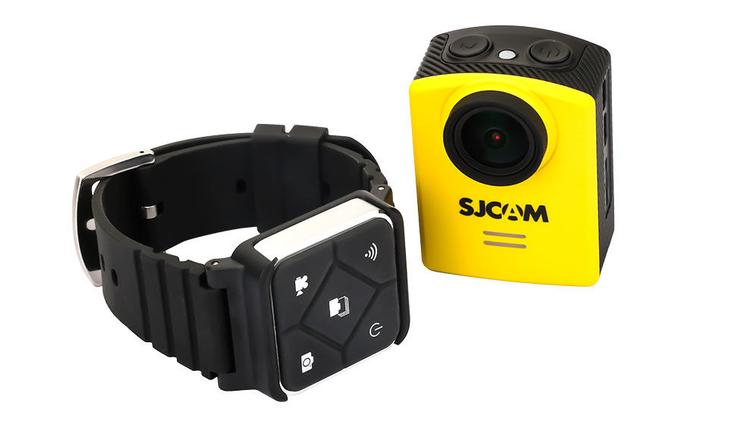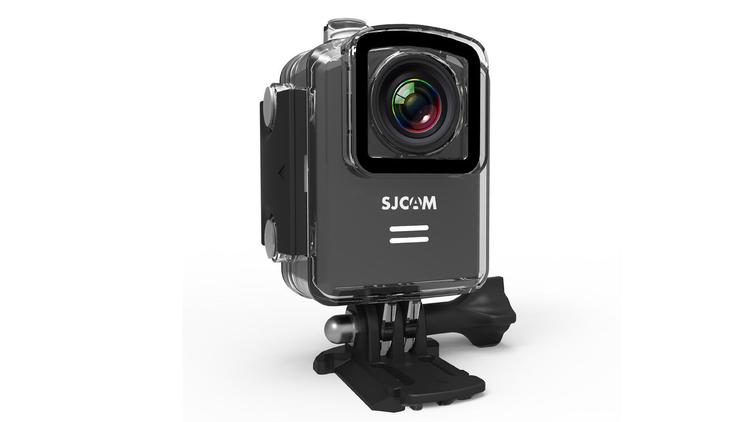Also see: Best Black Friday Camera Deals
SJCAM M20 review: Price
SJCAM offers free shipping to the UK, but you may have to pay import duty. See also: Pros and cons of buying from overseas. The M20 comes in seven colours: black, white, silver, gold, yellow, red and blue, all of which are the same price. A cheaper alternative, if you’re not too worried about size, weight or having gyro stabilisation, is the Ele Explorer at under £70. Another option is to buy the BoomYours bundle which includes the SJCAM M20, a 32GB card, an extra battery, separate charger and AV out cable for £100.99
SJCAM M20 review: Features
Although billed as a 4K action cam, the M20 is not capable of recording true 4K video. This isn’t a problem with the sensor – a 16MP Sony IMX206 – but the Novatek NTK96660 chipset. What the M20 offers is 2880×2160 pixels so, like the SJ500X before it, it’s merely interpolated video. SJCAM doesn’t hide this fact – it freely acknowledges it on its website. Essentially, it’s a slimmed down version of the SJ5000X with a higher-resolution sensor. The good news is that it will record 1080p at 60fps, and there’s a 2K mode (2560×1440 pixels) which doesn’t cheat by repeating frames. You can also choose lower resolutions down to VGA. What’s impressive at this price is that it also has gyro stabilisation. SJCAM doesn’t say exactly how this works, but work it does. Combined with the 1080p60 mode, it gives surprisingly smooth, stable footage. On the back is a 1.5in screen for framing and reviewing footage, plus changing the mode and settings. You also get built-in Wi-Fi and a companion app for iOS and Android that allows you to change settings, see the video feed, start and stop recordings and review and download clips. No microSD card is included, but SJCAM says there’s support for up to 128GB with “selected cards”. If you don’t want to take a chance, it will support pretty much any 32GB card. Here are the best microSD cards to buy. Charging is via microUSB, and video output is via micro HDMI (also used for FPV mode). On the other side are two buttons which act as up/down for menus and double as a toggle for Wi-Fi and also to bring up the ‘quick access’ menu that gives mode-specific options, such as the interval between photos in Photo Lapse and the slo-mo speed in Slow Rec. As well as the standard video and photo modes, there’s also Video Lapse (time-lapse video), Slow Rec (720p at 120fps or VGA at 240fps), Photo Lapse (photos taken every 3, 5, 10 or 20 seconds) and Burst Mode (3, 5 or 10 frames). In the waterproof housing, which is rated to 30m, you can enable the underwater mode which attempts to correct colours. You’ve also a choice when it comes to field of view: wide, middle, narrow or – strangely – off. If you’re going to use the M20 as a dash cam, there’s a dedicated ‘car’ mode which enables automatic recording when the power is turned on. You have a choice of 3, 5 or 10 minute loop recording, too. You can opt to embed a timestamp and even a registration plate to the video, but there’s no g-sensor nor GPS. Motion detection is a separate mode, but could come in handy in the car. LEDs on top and on the front show if you’re recording or not, and if Wi-Fi is on or not, but these aren’t especially easy to see in sunny conditions. There’s a single beep which indicates when you’ve started and stopped recording, but this is inaudible if you’re using the waterproof case. In the box you also get an open case which has handy tripod mounts on the top and bottom. The case has a removable belt clip; when removed you can see the M20’s screen. There’s also a selection of adhesive and rotating mounts, but no helmet or handlebar mounts.
SJCAM M20 review: Performance
Despite the large range of image quality settings which includes ISO, EV, colour and white balance, there’s nothing that lets you alter the metering method. In our tests, the M20 tended to overexpose everything and while you can use the EV correction, you shouldn’t have to. We left it set to 0, and found that even when an object was almost filling the frame, the camera would still meter for the dark background. The WDR mode (which displays on screen as HDR) doesn’t do much to improve matters: highlights (and even mid-tones in some cases) were still blown out in our test footage shown at the top of this review. And despite the Sony IMX206 sensor, detail in 1080p footage is lacking. Viewed on a large PC monitor, it’s obvious that there’s plenty of compression artefacts which turn details into smears, even if you’re holding the camera still. Even set to the highest image quality, the M20 only records at 30Mbit/s in 1080p60. Ramp up the resolution to 2K and not a whole lot changes: there’s still a lack of sharp detail. Audio quality is reasonably good, so long as you’re using the open case and you turn up the ‘volume’ in the settings to about 7 or 8. Inside the waterproof housing, there’s the expected muting of audio, but you’ll still hear muffled sounds if you use the highest recording volume level and adjust the gain when editing the footage. Each JPEG photo taken at maximum quality uses around 5MB. However, image quality is again disappointing. There are loads of compression artefacts which remove a lot of detail. You can shoot in RAW (files are over 20MB each) but it’s fiddly to open these: you have to download three separate tools, follow a YouTube video and then open the converted DNG file in Photoshop. Worse still, the files you end up with are little better than the JPGs: all you get is noise instead of JPEG compression artefacts. Here’s a JPEG (resized from 16MP to 2MP). It was taken as the widest field of view: Here’s a 100 percent crop of the photo so you can see the detail: Here’s another photo taken in RAW mode, converted to DNG and then processed using Photoshop’s RAW tool:
SJCAM M20 review: Battery life
SJCAM says that the 900mAh battery will last 75 minutes with Wi-Fi turned off, and 10 minutes less if you have it enabled. However, set to 1080p60, we were able to record a total of only 30 minutes. This was shooting occasional clips on a three-hour trip, and sometimes leaving the camera on between shots – by default it will power off after a couple of minutes. At least the battery is removable (unlike the Hero Session’s) so you can swap in a spare when it runs out. Currently, replacement batteries can be found on a few websites – including ebay – for around £6 each. Jim has been testing and reviewing products for over 20 years. His main beats include VPN services and antivirus. He also covers smart home tech, mesh Wi-Fi and electric bikes.




